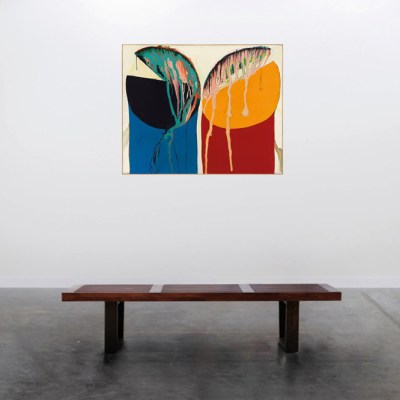Art Basel Hong Kong’s online viewing rooms initiative could not have been more timely. The digital platform had been in development for several months but was fast-tracked after the Hong Kong fair was cancelled in February due to the coronavirus outbreak. The organisers of the premier Asian fair quickly filled the gap with its new online facility, which was accessible to the public from 20–25 March (VIP access was granted two days earlier).
In total, 235 galleries – around 95 per cent of the fair’s original roster – showed more than 2,000 works, valued at a total of $270m according to Marc Spiegler, the global director of Art Basel’s fairs. The site, free of charge for galleries, offered basic options to view by artist, gallery, medium and price range. A zoom-in option to view works up close was available, while viewers could head down a rabbit hole and link through to other websites such as the video platform Vimeo for more content.
A totally virtual online fair experience sparked various reactions. Participating dealers were at least relieved that a trading facility was operating against the catastrophic economic backdrop. Richard Ingleby of the eponymous Edinburgh gallery said that he had received some enquiries but ‘can’t say that we’ve been rushed off our feet and nothing thus far [by day three] has led to a sale’.
‘With the opening bell of Art Basel, both seasoned and new collectors from Asia and Europe bought eight works,’ says Iwan Wirth, co-president of Hauser & Wirth, which sold a number of works by Paul McCarthy including Mary Magdalene Red Waterfall (2017; $300,000), and an untitled work on paper from the 1960s by Luchita Hurtado, priced at $50,000.
‘Much is being said about digital: it is just the new norm. We’ve done it for years and it shows; our clients use it,’ Wirth says. Indeed, numerous transactions took place via galleries’ own virtual platforms, reflecting how blue-chip dealers are reaping the rewards of carving out more substantial spaces online in recent years.
‘For years, we regularly sold works via PDFs and JPEGs, and saw an online viewing room as a natural evolution,’ says Elena Soboleva. She adds that David Zwirner, where she is director of online sales, was the first commercial gallery to introduce an online viewing room in 2017, stressing that ‘the online space has become a core element in the gallery’s overall strategy’. The gallery has since presented 54 viewing rooms, some of which draw on scholarly and archival materials.
‘We programme them as we would programme a physical gallery space,’ Soboleva says, ‘presenting curated exhibitions that range from historical shows […] to premieres of new bodies of work by cutting-edge contemporary artists.’ She cites numerous advantages, from removing the ‘intimidation factor’ for novice collectors nervous about buying art for the first time to the issue of increasing price transparency.
In the Art Basel Hong Kong viewing rooms, all works were displayed with a price, or a price range, a move that appeals to new collectors, says Wirth (galleries often keep prices confidential at art fairs, guarding them like state secrets). ‘It’s not perfect – price ranges are still the majority, and can be as broad as $500,000 to $1m – but it’s a big leap in a healthy direction,’ says Melanie Gerlis, editor-at-large at the Art Newspaper.
Collectors claim the viewing rooms will only succeed, however, if the technical specifications are top-notch, and also if buyers have prior knowledge of an artist’s work and practice. The London-based collector Christian Levett says that the rooms are ‘excellent if you’re viewing a work by an artist that you already know well, and where a very high-resolution image is provided of the front and back, with an extremely detailed condition report’. He would be wary of buying works online by artists not known to him.
Gallerists must evidently present works in the best possible light, says Miami-based collector Dennis Scholl, pointing to ‘one of the best presentations’ he has seen so far: a group of four watercolours on Japanese washi paper by Sam Gilliam displayed in Pace Gallery’s own viewing rooms, priced at $180,000 each.
The other major stakeholders in the burgeoning online conversation are artists who may feel that digital platforms are too limiting, and poor vehicles for their paintings and sculptures. US artist Angel Otero’s work Untitled (2019) was available with Lehmann Maupin in the Art Basel viewing rooms (price range $50,000–$100,000).
‘Considering the times we’re living in, I think perhaps [viewing rooms] are necessary. But I didn’t create the work with the intention of it being seen in this way, and it is a little sad to accept this new reality,’ Otero says, adding that he is optimistic such new platforms can lead to more accessible ways of viewing art.
Like many other art-world figures, he believes that the physical act of seeing a painting is paramount. ‘I’m still attached to the romantic idea that having conversations about a work of art as you stand in front of it is priceless,’ he says.
Whether the coronavirus crisis is a turning point for the art market and its approach to all things digital remains to be seen. The New York-based art adviser Nilani Trent is adamant that online viewing rooms will not replace art fairs in a healthy market, pointing to the demise of the VIP Art Fair, the first online-only fair, which flopped in 2011, mainly because of technical glitches.
Trent gives the most pithy assessment of the current situation, saying that the ‘viewing rooms encouraged sales at all levels, bringing one day less of anxiety for everyone’, which, for now, is surely a saving grace.
From the May 2020 issue of Apollo. Preview and subscribe here.



